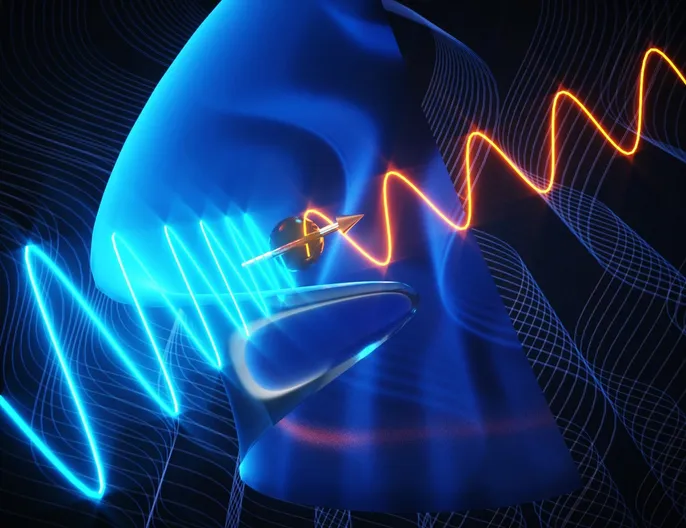According to the standard model of particle physics, scientists currently describe the best theory of the most basic components of the universe. Particles called quarks (which make up protons and neutrons) and leptons (including electrons) make up all known matter. Force carrying particles, belonging to the broader group of bosons, affect quarks and leptons. Although the standard model is successful in explaining the universe, it also has its limitations. Dark matter and dark energy are two examples, and the undiscovered new particles may finally solve these mysteries**

On Wednesday, an interdisciplinary team of scientists led by Boston College physicists announced that they had discovered a new particle -- or a previously undetectable quantum excitation -- called the axial Higgs mode, which is a magnetic relative of the Higgs boson particle that determines the mass. On June 8, the team made a report in Nature 》Their report was published in the online edition of the magazine.
A decade ago, the detection of the long sought Higgs boson became the core of understanding mass. Boston College Physics Professor Kenneth Burch said that unlike its parent, the axial Higgs mode has a magnetic moment, which requires a more complex theoretical form to explain its characteristics. He is the main coauthor of this new study.
Burch said that the theory that predicted the existence of this model was used to explain "dark matter", a nearly invisible substance that makes up most of the universe but only shows itself through gravity.
The Higgs boson was discovered through experiments in the large-scale particle collider, while the team focused on rare earth metal telluride (rte3), a well studied quantum material that can be inspected in the form of "desktop" experiments at room temperature.
"You don't find new particles on the 'desktop' every day," Burch said
Burch said that the characteristics of rte3 mimic the theory of axial Higgs mode. But in general, he said, the central challenge in finding Higgs particles is their weak coupling with experimental probes such as light beams. Similarly, revealing the subtle quantum properties of particles usually requires quite complex experimental devices, including huge magnets and high-power lasers, while cooling the samples to extremely low temperatures.
The team reported that it had overcome these challenges by making unique use of light scattering and by properly selecting a quantum simulator (essentially a material that mimics the required properties for Research).
Specifically, researchers focused on a compound that has long been known to have a "charge density wave," a state in which electrons self organize at periodic densities in space, Burch said.
He added that the basic theory of this wave mimics the components of the standard model of particle physics. However, in this case, the charge density wave is quite special. It occurs far above room temperature and involves the modulation of charge density and atomic orbital. This makes the Higgs boson associated with this charge density wave have an additional component, that is, it may be axial, which means that it contains angular momentum.
To reveal the subtle nature of this pattern, Burch explained that the team used light scattering, that is, irradiating the material with a laser, which can change the color and polarization. The change of color is due to the Higgs boson produced by light in the material, and the polarization is sensitive to the symmetry of the particles.
"Therefore, we were able to reveal the hidden magnetic components and prove the discovery of the first axial Higgs mode," Burch said.
Burch said: "In high-energy particle physics, the detection of axial Higgs is predicted to explain dark matter. However, it has never been observed. Its appearance in a condensed matter system is completely surprising and indicates the discovery of a new broken symmetry state that has not been predicted. Unlike the extreme conditions usually required to observe new particles, this is done in a tabletop experiment at room temperature. We only need to change the polarization of light to achieve this." Now the quantum control of this mode. "
Burch said that the seemingly easy to obtain and direct experimental technology deployed by the team can be applied to research in other fields.
"Many of these experiments were done by an undergraduate student in our lab," Burch said. "This method can be directly applied to the quantum properties of many collective phenomena, including superconductors, magnets, Ferroelectrics and modes in charge density waves. In addition, we have brought the study of quantum interference in materials with related and / or topological phases to room temperature, overcoming the difficulties of extreme experimental conditions."
In addition to Burch, Boston College's co authors of the report include undergraduate grant McNamara, newly graduated doctoral student Yiping Wang and postdoctoral researcher MD mofazzel Hosen. Burch said that Wang won the best paper award in magnetism from the American Physical Society, partly because of her work on the project.
Burch said it was crucial to draw on the extensive expertise of researchers from British Columbia, Harvard University, Princeton University, the University of Massachusetts, the University of Massachusetts Amherst, Yale University, the University of Washington and the Chinese Academy of Sciences.
"This shows the power of interdisciplinary efforts to reveal and control new phenomena. You don't get optics, chemistry, physical theory, material science and physics in one job every day," Burch said
In addition, by properly selecting the incident and outgoing polarization, particles with different components can be created - such as a non-magnetic particle or a component pointing upward. Using a fundamental aspect of quantum mechanics, they took advantage of the fact that for a configuration, these components would be offset. However, for different configurations, they increase.